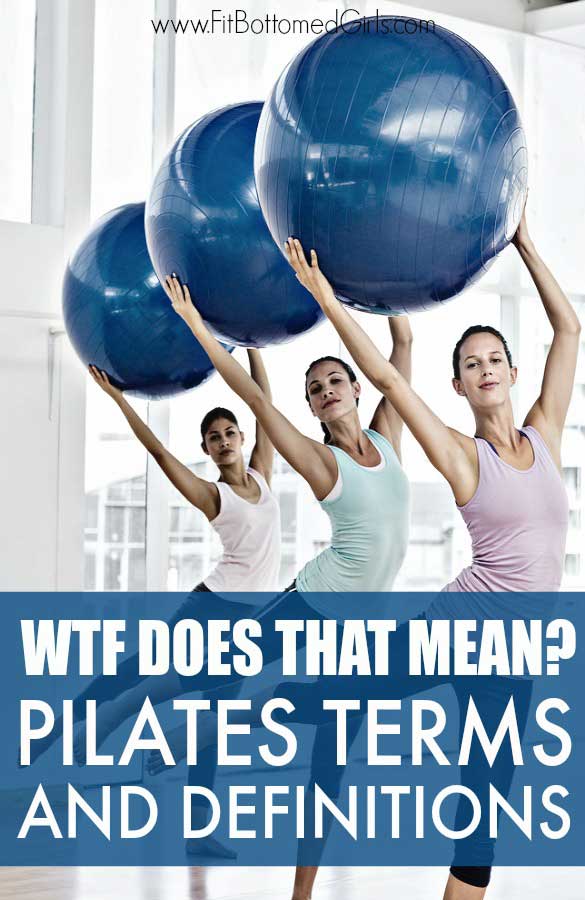WTF Does That Mean: Pilates Terms and Definitions
Continuing with our WTF Does That Mean Series, let’s talk Pilates!
My first knowledge of Pilates came from Leslie Golub of Leslie’s Total Fitness in Deerfield Ill. Leslie was trained and certified in 1989 at the New York Institute Movement Science. Her second certification came from The Physicalmind Institute in New Mexico. Leslie has taught at a dozen facilities in the Midwest and has owned her own studios since 1991. She now teaches out of her home in Deerfield.
Leslie began taking Pilates in the late 80s in New York. “What drew me to the work, being a dancer, was the idea of working from the inside-out. Finding the muscles closer to the skeleton rather than the skin. Teaching Pilates now since 1991, I often tell my clients, ‘Work from your center rather than working from your periphery’. It allows my students to find those smaller, deeper muscles which are much harder to find than those larger, more superficial muscles. When working from the inside-out, the movement becomes more graceful and deliberate.”
But working those small muscles requires all kinds of Pilates-specific terminology. So what does it all mean?
Common Pilates Terms
Lets first break down the three most commonly used Pilate practices:
Classical Pilates: Teachings of the exact same exercise in the exact same order with a pelvic tilt. This focus of Pilates is on quality over quantity.
Winsor Pilates: Based on traditional Pilates method, this concentrates on deep stretching and focused breathing.
Reformer: This apparatus is a sophisticated system of springs, straps and pulleys with a gliding platform that you can sit, kneel, stand or lie on the front back or side of. The springs allow for progressive resistance, helping to strengthen and lengthen the muscles in a progressive matter. The entire apparatus is designed to promote torso stability and postural alignment.
When attending a class or watching a video, here are some common terms you will hear when referring to Pilates movements and positioning of the body.
Naval to Spine: The process of drawing your abdominal muscles up and in. Imagine your navel being drawn towards your spine, as though a string is connected pulling it back.
Neutral Spine: Rather than flattening your spine or pressing it into the floor, here the spine remains at its neutral curve. If the spine is misaligned, it can cause surrounding muscles to work too hard and over compensate for the spine, resulting in fatigue, pain and potential injury.
Centering: Physically and consciously bringing the focus to the center of the body. All Pilates exercises originate from the center, the core area between the lower ribs and pubic bone.
Power House: The torso area that includes the muscles of the abdomen, the pelvic region, the lower back and the buttocks.
Doming Abs: Abdominal muscles that are pushed out, rather than pulled in, on contraction.
Flow: Being fluid and graceful, keeping each movement in a flowing manner.
Supine: Lying on your back, head faces up.
Prone: Lying face down.
Concentric: Shortening of the muscle.
Eccentric: Lengthening of the muscles.
Extension: Straightening out a limb while using the muscle.
Flexion: Bending a limb with use of the muscle.
Hyperextension: Stretching a limb, beyond normal range of movement and motion.
Rotation: Twisting around a central axis.
Abduction: Contraction of a muscle that occurs in the middle of the body.
Adduction: Contraction that draws towards the midline.
Are there any confusing terms that didn’t make the list? Let us know in the comments! Let’s be honest — there’s a lot to keep track of! —Jennifer


Comments
This was so helpful! Thanks!
Personally, I think if your pilates instructor is using that many anatomical terms without explaining their meaning, then they are not doing a very good job of teaching pilates!
I went to a Pilates class with a girlfriend last week and I loved it. I was a little lost as the class went on and I think It’s because I dint know what the Pilates terms were! This is very helpful, and at least I wont look so lost next time!
I found your definition of Abduction a little confusing. Abduction is moving the limb away from the body I believe
I’m new to Pilates and when they said to get in mermaid pose, plank, child pose and more, I had no clue what they were talking about.
Comments are closed.